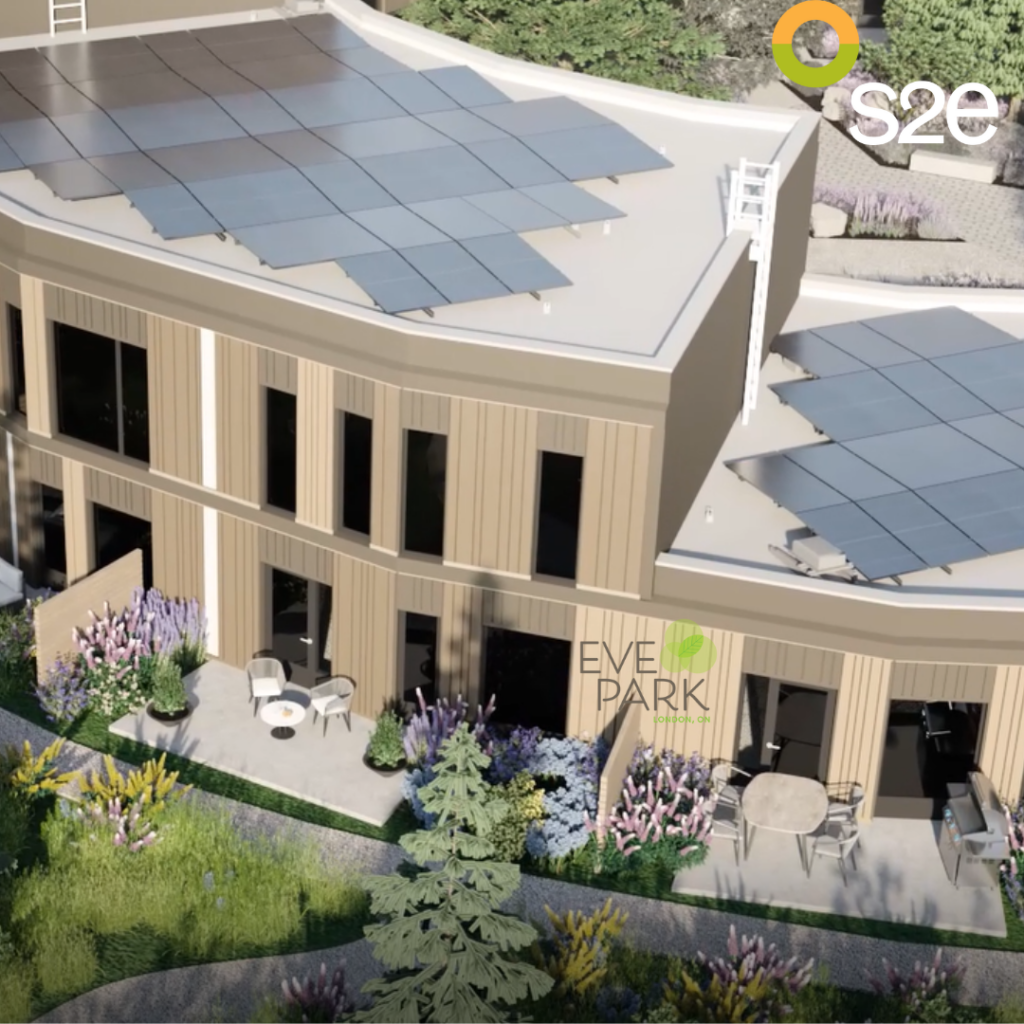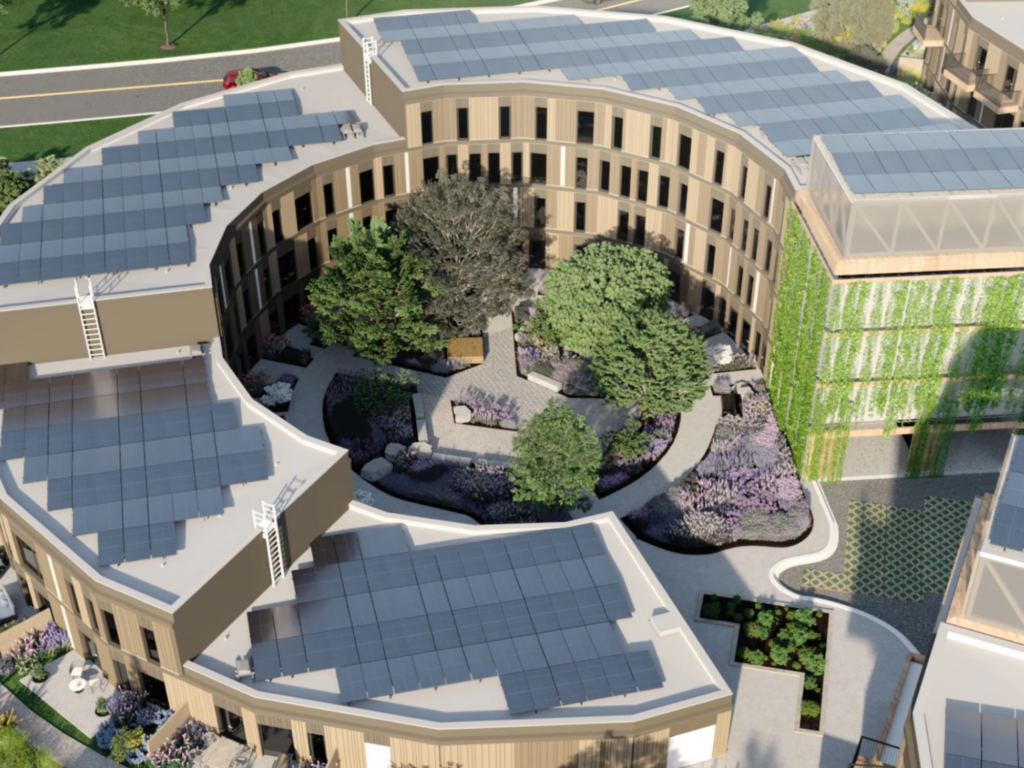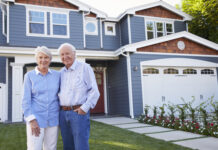By Natasha Rombough, Director of Marketing and Communications, CHBA
In London, Ont., a new kind of community is rising up. EVE Park, by developer s2e Technologies Developments, is not only architecturally fascinating, it shows just how livable a sustainable home can be.
Beginnings
EVE Park is part of the Greater Sustainable West 5 Community – North America’s first and largest mixed-use net zero community. Starting in 2014, s2e played a seminal role in the creation of West 5 by bringing together the project’s research partners, knitting together an innovative vision and advising West 5’s developer, Sifton Properties, on renewable energy technologies. In 2017, s2e started on the next logical step: Reconceptualizing housing through a broader sustainability lens; net zero, of course, but also disrupting existing market assumptions about the relationship of housing to mobility, land use and more. The outcome is now under construction with the first phase nearly sold out and the second phase soon to begin.
Project Lead Ashley Hammerbacher has an undergraduate degree in Bioengineering and a graduate degree in Civil and Environmental Engineering. To make it all happen, Hammerbacher credits the unique and heavy-hitting project team they assembled. “The idea was to bring in a wealth of experience and creativity from international players to come up with something unique and cutting-edge,” she says. “Then we critically found a lot of local partners to help with implementation. They ensured the project could be built in London – everything from accessing resources, to adopting modular construction techniques that could be used to reduce on-site construction waste.”
The result is a design that some have described as futuristic, while others note echoes of historic European courtyards. Four helical clusters of Net Zero townhomes and stacked townhomes with solar panels on the roofs are each wrapped around a shared greenspace. Every cluster starts with one storey, then goes up to two, then three and four as it ramps up around the circle, and each cluster has 21 units. The low end of the building has shared services (such as mail and garbage), and the high end of the building terminates with a pair of enclosed rotational parking towers.
Sustainable beyond just building emissions
Where we live and how we get around produce two of our biggest emissions streams. EVE Park gives consumers the choice to radically reduce both at the same time. The site is a quick walk to West 5 amenities, and to nearby parkland. For errands slightly farther afield, there are plans for an e-bike share. To help people off-ramp from internal combustion engines, residents can opt-in to an EV car share program (EVE-Car), which is planned to eventually be made available to the broader West 5 Community.
Hammerbacher says that the option to do without a second car has been a sales draw. The annual savings gained by not needing a second car, combined with the comfort of knowing one will be there if needed, is attractive to buyers.

A key reason for parking towers was to create greenspace, which enhances quality of life for residents. The towers also have a practical advantage. What makes EVE Park’s garage innovative is the integration of a high-capacity EV charger fixed in the tower, with the cars rotating around it. This solution deals with the increasingly common headache of waiting for a free charging spot.
Residents will be able to access their vehicle quickly and easily through an app. It’s a method of parking that can certainly be used by larger developments that have greater parking requirements, with some adaptations, says Hammerbacher. “It’s a very versatile solution that is really popular in Asia and some European areas, where there are very large deployments with multiple towers,” she explains. “We are not reinventing the wheel, which is comforting. From a mechanics perspective it’s quite simple.” Given that s2e says parking carousels can reduce land given to surface parking by a factor of eight, it’s an option other developers may want to consider.
Powering a neighbourhood
One of the big hurdles that Net Zero builders often face is regarding the local electrical grid. Unless the home has batteries, which are still quite costly, most net zero homes sell excess electricity created by solar panels back to the municipality. The costs incurred during times of low production are offset by that excess profit, resulting in net zero energy consumption. The problem is that many municipalities are not yet ready for such a setup, which makes blazing the trail particularly challenging for those builders first out of the gate in their area.
EVE Park didn’t experience the same challenges in that regard, thanks in part to s2e’s involvement with West 5 starting in 2014. The relationships built with London Hydro and the City of London for that project meant that the groundwork already existed for EVE Park. According to s2e, London Hydro has been a particularly forward-looking partner. The utility’s support for the project may have contributed to London getting a major Net Zero community built before New York, Toronto, San Francisco or any other city in North America.
The work-from-home trend has made resilience of residential power supply a higher consumer priority. The greater West 5 micro-grid, to which EVE Park is connected, has a battery system that serves the entire community in the event of a temporary power outage. The system was sized looking at historical outage events and has the capacity to cover for the majority of them.

Livable homes
Each of the 84 homes in EVE Park include their own private entrance, fully equipped kitchen, in-suite laundry and eco-friendly finishes. They come with one, two, three or four bedrooms. Since all units needed to be energy-modelled to ensure they could operate at a Net Zero, appliances were pre-selected by s2e.
But is the fact that the home is Net Zero attractive to buyers? Hammerbacher says that different aspects speak to different people. Some are really interested in air tightness from a health perspective and it’s a powerful selling point for them. Others are fascinated with the EV side of things. “Purchasers are aware of the climate crisis,” she says. “They’re aware that our product is sustainable and not just green washing. I’ve been inspired with the things that people are interested in.”
Credit for that can at least partially be attributed to how s2e has trained their sales staff. They’re made aware of not only the facts about the technology in the homes they’re selling, but how it affects the health, wellbeing, and the total cost of ownership for residents – like the fact that having a second car costs the average household more than they think, and that an energy-efficient, no-gas, net zero home tied to the grid with a net-metering contract future-proofs buyers against energy price inflation.
Replicable communities
Like most who are passionate about limiting our impact on the planet, s2e hopes that other developers see that Net Zero communities are very possible and can be done across Canada. The technology is readily available; it is how it’s used that makes EVE Park unique, and they look forward to even more innovation coming from others. Hammerbacher has high hopes for the future. “It would be great to see this community inspire developers across Canada, North America, and the world to try it as well. Let’s all do it!”







![Eve park ariel solar panelsjpeg[58]](https://buildingexcellence.ca/wp-content/uploads/2023/12/Eve-park-ariel-solar-panelsjpeg58-696x311.jpeg)




